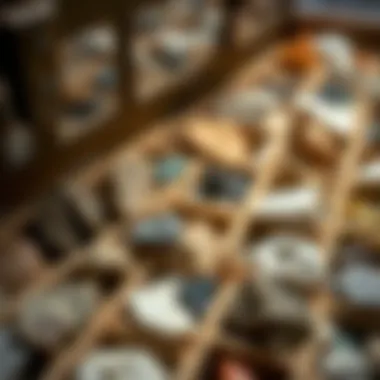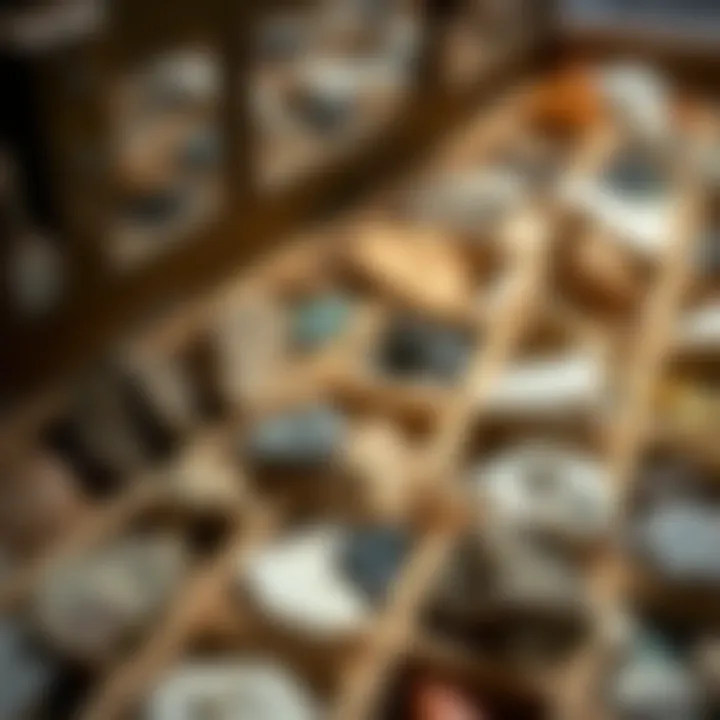Large Rock Collection Box: A Comprehensive Guide


Intro
In the world of geology, there is an unyielding passion that sparks a unique interest among collectors. At the heart of this passion lies the desire to preserve, organize, and display a myriad of geological specimens. The large rock collection box stands as a cornerstone in this endeavor, offering both utility and artistry. This article aims to delve into the nuances of such boxes, revealing their significance, construction materials, design considerations, and effective preservation techniques.
Understanding the intricacies of a large rock collection box goes beyond the mere storage of rocks. We will explore various factors—from the size and design to the organizational strategies collectors utilize. Our approach is not just about maintaining a collection but also enhancing the appreciation and understanding of these geological treasures.
As collectors journey through this article, they will uncover practical advice tailored to different levels of collecting experience. Whether you are a seasoned expert or a beginner just dipping your toes into geology, this guide will illuminate the path ahead.
Featured Collectible of the Month
Overview
This month, we shine a spotlight on the exquisite Amethyst Geode, a true marvel of nature. Amethyst, famous for its vibrant purple hue, has captivated collectors and enthusiasts alike. The geode form reveals the stunning crystalline structures that lie within, making it not only a collectible but also a conversation starter.
Historical Significance
Amethyst has held considerable importance throughout history. Believed by the ancient Greeks to have protective qualities, it was often used in jewelry and artifacts. Over the centuries, this gemstone has transitioned from a symbol of royalty in the 18th century to a cherished collectible today. Each geode tells its own story, linking the modern collector with ancient civilizations.
"Amethyst serves as a reminder of the earth's transformative power, turning the simplest minerals into breathtaking treasures."
Identification Techniques
For those eager to dive deeper into the world of geological specimens, identification techniques serve as essential tools. Recognizing the characteristics of various rocks and minerals can elevate the collection experience.
Visual Characteristics
When identifying rocks, begin by examining several key visual traits:
- Color: The hue can indicate the type of mineral present. For example, the deep purple of amethyst can distinguish it from similar-looking stones.
- Texture: How a rock feels can provide clues about its origin. Rough, jagged surfaces often hint at a more geological process than smooth finishes.
- Luster: Is the rock shiny, dull, or glassy? Luster offers insight into its mineral composition.
Resources for Identification
Navigating the field of rock identification might seem daunting, but numerous resources are available:
- Books on geology: Titles like Roadside Geology of Your State offer details on local rock types.
- Websites: For instance, Wikipedia on Geodes or Britannica can provide foundational knowledge.
- Community forums: Engage with fellow collectors on platforms like Reddit or Facebook groups dedicated to geology.
- Local geological societies: Many offer workshops and field trips for hands-on learning experiences.
As we continue through the narrative of large rock collection boxes, an appreciation for the delicate balance of preservation and display is crucial. Collectors are invited to reflect on their own journeys, learning the best practices for maintaining the integrity of their cherished specimens.
Understanding the Role of a Rock Collection Box
In the world of geology and collecting, having a dedicated space for your prized specimens isn’t just about aesthetics; it’s a fundamental aspect of preserving the integrity of those pieces. A rock collection box serves as more than merely a container. It acts as a sanctuary for geological treasures that collectors have spent time, effort, and sometimes a good chunk of change to acquire. This section dives into what makes a rock collection box vital to anyone serious about the craft.
The primary purpose of a rock collection box is to organize and protect specimens from environmental damage, such as moisture, dust, and temperature fluctuations. Without proper containment, those hard-earned finds could succumb to scratches, fading, or degradation. When you think about the effort it takes to locate unique rocks—like the rare Blue John fluorite or the vibrant orange calcite—putting them in just any old drawer is simply not an option.
Furthermore, a well-constructed collection box enables collectors to display their findings in a manner that’s not only organized but is also visually appealing. Often, showcasing rocks can ignite conversations and deepen one's passion for geology. Imagine having a well-arranged series of rocks specific to a locality, and being able to share the stories behind each piece in a way that’s engaging for others.
Having a designated collection box can also facilitate easy cataloging. For example, some collectors opt for dividers that allow them to sort rocks by type or origin. This isn’t just for ease of access; it helps you to create a narrative around your collection. Each compartment can represent a different adventure or geological epoch, making the experience truly personal.
The right collection box enriches the act of collecting, turning what might be a simple hobby into an engaging journey through time and geography.
The role of a rock collection box extends beyond mere storage; it is an essential tool for collectors, enhancing the way they engage with their specimens and the stories they tell.
Definition and Purpose
To understand the scope of utility provided by a rock collection box, we must first dig into what it really is. In simplest terms, a rock collection box is a sturdy container that holds, organizes, and protects geological specimens. Depending on the builder's expertise, these boxes can vary widely in material, size, and design. Generally, they feature compartments or slots where individual stones can be securely placed without risk of snapping or chipping.
Now, it’s key to highlight that these boxes are not homogenous. Various types cater to different preferences, budgets, and specific collecting habits. The purpose of this diversity is straightforward: different rock specimens have unique needs. For instance, softer stones may require more cushioning than their harder counterparts, leading some enthusiasts to choose boxes with padded interiors or compartments lined with felt.
As for the broader purpose, a good collection box does more than house rocks; it encourages organization. A properly curated collection box allows collectors to reflect on and appreciate their haul while keeping everything tidy. It fosters an environment where each stone is treated with respect, making the hobby more rewarding.
Historical Context of Collecting Rocks
Understanding the roots of rock collecting can add another layer of appreciation for why a collection box is essential. Rock collecting as a hobby traces back to early human civilization when individuals began to gather natural curiosities not just for practical uses but also for aesthetic enjoyment. Archaeologists have found evidence that ancient cultures, like the Egyptians and Greeks, collected stones, often using them for decorative purposes in jewelry or architecture.


During the 18th and 19th centuries, collecting rocks transitioned from a less formal pastime to a respected pursuit among scholars and scientists. This was a time when geology became a formal study. Collectors began documenting their finds, leading to an organized approach to curation. They often stored their specimens in custom-built boxes or even wooden cabinets, providing a glimpse into the past of geological study.
The ill-fated expedition of the Lewis and Clark team in the early 1800s, which included detailed documentation of their geological finds, ignited a wave of interest in the natural sciences. Combined with the enthusiasm for exploration during that age, it set the stage for modern rock collecting. As the hobby gained traction, so did the need for storage solutions that could provide both protection and display. This evolution naturally led to the development of rock collection boxes.
Thus, the rock collection box not only serves a practical purpose today but also represents a rich history of curiosity about Earth’s materials and the human journey toward understanding the natural world.
Types of Rock Collection Boxes
Selecting the right type of rock collection box is crucial for anyone who wants to keep their geological treasures organized and preserved. The type of box can significantly impact how well your collection is maintained over time. Each material presents unique attributes and benefits, catering to various preferences and styles of collectors.
Wooden Collection Boxes
Wooden collection boxes have a certain charm and warmth that many collectors appreciate. The natural aesthetic can complement the beauty of the rocks themselves. Depending on the type of wood used, these boxes can provide varying levels of durability and resistance to the elements. For instance, hardwoods like oak and maple offer sturdy constructions, making them less prone to warping or cracking compared to softer woods.
An important factor to consider is how well the wood is finished. A well-sealed wooden box can help keep moisture at bay, which is critical in preventing mold or damage to specimens. One might opt for a box with soft linings to prevent scratching or unintentional damage while sliding rocks in and out. However, maintain in mind that over time, wooden boxes can require maintenance like polishing or sealing to prolong their lifespan.
"Investing in a wooden collection box isn’t just practical; it’s about creating a space that reflects your passion for geology."
Plastic and Acrylic Options
On the other end of the spectrum, plastic and acrylic collection boxes provide a modern alternative. They are often lightweight and come in various styles and sizes, making them quite versatile. These materials are also less prone to damage from moisture compared to wood. Many collectors favor acrylic as it offers a clear view of the specimens inside, allowing for easy display while keeping them safe from external elements.
When choosing plastic boxes, be aware of the material's quality. Not all plastics are equal, and some can become brittle over time or degrade when exposed to sunlight. Furthermore, boxes with compartments can help in organizing specimens according to size or type, making it easier to find your favorites at a glance.
Glass Display Cases
For those looking to showcase their collections while ensuring maximum protection, glass display cases often fit the bill. These provide an elegant way to display rock specimens in a dust-free environment, which is crucial for long-term preservation. Glass can bring out the colors and textures found in many geological specimens, adding an artistic touch to any room.
However, glass cases can be fragile and should be handled with care. It's essential to ensure the stability of the case, especially if it’s placed in a high-traffic area or near children. When equipped with proper lighting, glass cases can transform parts of your home into mini-museums, highlighting the intricate details in your collection.
Constructing the Ideal Collection Box
When it comes to building the perfect rock collection box, it’s not just about aesthetics. The way you construct your box plays a crucial role in ensuring your specimens remain in tip-top shape. This section discusses key elements such as the material, size, and how these factors can influence the preservation of your geological treasures.
Material Selection
Choosing the right material for your collection box is fundamental. It’s like picking the right vessel for an expensive wine; you want something that protects, showcases, and lasts through time.
Durability Factors
Durability is the backbone of any good collection box. A well-made box will withstand the wear and tear from moving, transporting, and even the occasional bump in the night when the family dog decides to make its rounds.
High-quality wood or robust plastic can offer the longevity you need. Wood can be sturdy, yet vulnerable to moisture if not treated correctly. On the other hand, thick plastic is quite resilient but might lack that classic look of wood.
Therefore, one should remember, choosing a material that balances appearance and function will minimize risks for rock damage. Selecting a durable material means avoiding replacements and disruptions in your collection.
Environmental Considerations
Environmental considerations are increasingly significant in today's context. Opting for materials derived from sustainable sources showcases a commitment to ecological balance.
Recycled plastics or responsibly sourced wood can be favorable choices. They not only protect your rock specimens but also hold a narrative of sustainability. Naturally, pricing can fluctuate, but the moral benefit of preserving our planet may outweigh costs.
In short, selecting materials that can withstand both physical and environmental stresses can enhance your collection box's longevity, while also being kind to Mother Earth.
Size Considerations
Size matters, especially when it comes to a rock collection box. It’s like buying a new refrigerator—getting one that fits your kitchen is essential. A collection box must have enough volume for your current specimens but also some wiggle room for future additions.
Volume for Various Specimens
The volume necessary for your specimens should reflect the types of rocks you’ve collected. Dense specimens like the granite might need more space than lighter ones like pumice. This is all about accommodating the different sizes in your collection—no one wants to cram a hefty quartz chunk next to a delicate fossil.
An optimal volume allows for organization and prevents any undue pressure on individual specimens, ultimately giving them the space they deserve. Choosing a box that boasts ample volume can also showcase your collection beautifully, fostering a sense of pride as you gaze upon each unique piece.


Space for Future Expansions
Think of space for future expansions as a plan for a growing family. You don’t want a box that feels like a sardine can after just a few additions. This foresight is something that both casual and avid rock collectors should consider.
Opting for a larger box or one with adjustable compartments can ensure you’re not boxed in later. Think about how your collection might evolve. By keeping space in mind, you're guaranteeing that your box remains functional and reflective of your collecting journey, allowing growth while being practical.
"A well-constructed rock collection box not only protects but inspires ongoing discovery and enthusiasm."
Preservation Techniques and Care
In the realm of rock collecting, the value of a collection extends beyond the inherent beauty and geological significance of each specimen. Preservation techniques and proper care are paramount to ensuring these precious rocks remain in pristine condition. Environmental factors play a substantial role in the deterioration or preservation of various geological specimens. Therefore, collectors must take deliberate measures to safeguard their collections, enhancing their lifespan and maintaining their aesthetic and scientific value.
Humidity Control
Humidity management is critical in preventing the degradation of rocks and minerals. High humidity can lead to mold growth, particularly in porous specimens like limestone and some types of sandstone. Just picture it: a prized specimen, perhaps a beautifully layered sedimentary rock, developing spots of mold because of a humid environment. Preventing such scenarios is easier than one might think.
A humidity range of 30% to 50% is typically ideal for most geological specimens. Here are a few techniques to keep moisture at bay:
- Desiccants: Utilize silica gel packets or unbleached cat litter, as they are natural moisture absorbers. Place them in your collection box; they'll help absorb excess humidity without being intrusive.
- Climate Control: If possible, keep the collection box in a climate-controlled room. Air conditioning can significantly help maintain stable humidity levels.
- Humidity Monitors: Keep an eye on the conditions with a hygrometer. These devices can help you track the humidity levels in your collection box. It's a simple yet effective way to ensure you don't allow conditions to slip away unnoticed.
Temperature Regulation
Temperature plays a crucial role in the preservation of rocks. Too much heat can alter the structure and colors of certain specimens, while excessive cold can lead to cracking. The ideal temperature for most rock specimens usually hovers around room temperature—between 68°F and 75°F (20°C to 24°C). Maintaining this temperature can prevent various forms of damage. Here’s how you can regulate temperature effectively:
- Placement: Position your collection box away from drafts, heaters, or direct sunlight. Sunlight, while welcoming, can also contribute to heat fluctuations that could warp delicate specimens.
- Insulation: Consider using insulated display cases to help stabilize temperature fluctuations, especially if that's a concern in your area.
- Thermometers: Just like humidity, investing in a thermometer to monitor temperatures could save you the headache of damaged specimens. It's a straightforward way to keep tabs on the condition of your collection.
"Temperature and humidity management go hand-in-hand in preserving your specimens; neglecting one could render your collecting efforts futile."
By acknowledging the impact of both humidity and temperature, rock collectors can create an environment that not only protects their valuable specimens but also enhances their enjoyment of this fascinating hobby. Proper preservation techniques are your best line of defense against the elements, ensuring that your rocks remain in excellent condition for years to come.
Organizing Your Collection
Organizing a rock collection might seem like a simple task at first glance, but it holds considerable importance in preserving both the physical integrity of the specimens and the enthusiastic connection one feels toward them. A well-organized collection not only showcases the beauty of geological wonders but also allows for easier inventory management and educational opportunities. To truly appreciate what each rock has to offer, collectors must devote attention to specific elements, benefits, and considerations when organizing their treasures.
Categorization Methods
Establishing a categorization system is paramount in organizing a rock collection. This can be done effectively through two major methods: sorting by rock type or by geographical origin. Each method brings its own advantages and provides a unique way to interact with the collection.
By Rock Type
Sorting rocks by type allows collectors to easily identify similarities and differences among their specimens. This method emphasizes the characteristics of formations, such as igneous, sedimentary, and metamorphic rocks. The key characteristic of using this method is that it simplifies the process of comparison, enabling collectors to deepen their understanding of geological processes. This method is not only beneficial but also popular among enthusiasts who enjoy categorizing their rocks based on physical properties.
In terms of unique features, one might find that displaying rocks by type brings an aesthetic quality to the setup. However, it does have its disadvantages. For instance, it might not reflect the collector's personal journey or stories associated with each piece, which could lead to a less engaging narrative for visitors.
By Geographical Origin
Organizing by geographical origin has a distinct charm and educational value. This approach allows collectors to appreciate the diversity of rocks not just for their intrinsic attributes but also for their historical and cultural significance. The key characteristic of this method is its ability to tell a story about the diverse landscapes from which the specimens come. For instance, a collection might consist of petrified wood from Arizona or granite from the Sierra Nevada, highlighting geological processes across different regions.
One unique feature of this method is the opportunity to create a narrative around each rock's journey. It makes the collection not just a display of geological beauty but also a reflection of world geography and earth science. However, a potential disadvantage is that the emphasis may shift from the rocks’ characteristics to their locations, potentially undermining a deeper understanding of their geologic formation.
Creative Presentation Ideas
Once the categorization methods are in place, the next step is to think about how to display the collection creatively, making it engaging and informative for anyone who views it. Effective presentation can significantly enhance a collection's appeal and educational value.
Display Techniques
Display techniques can elevate a collection from a mere gathering of rocks to an inspiring showcase. Various methods, such as backlighting, shadow boxes, or even natural settings, can highlight each specimen's unique attributes. A notable advantage of effective display techniques is that they draw visitors in, sparking curiosity and promoting discussion about geology and natural history.
However, an essential consideration is the risk of overcomplicating the display. If not chosen wisely, some techniques could overshadow the specimens themselves rather than enhancing their beauty or significance. It’s a balancing act, where simplicity and elegance typically win over extravagance.
Labeling Systems
Labeling systems are another critical aspect of presentation. Clear labels contribute to understanding and appreciating each specimen's context, such as the rock type, location, and any significant geological information. An effective labeling system informs viewers and also helps collectors keep track of their specimens, ensuring no piece gets overlooked or disregarded.


The key characteristic of a good labeling system is clarity—labels should be easy to read and understand. They can include QR codes that lead to further information online, or they can simply convey the necessary details without getting too cluttered. However, care must be taken to avoid making labels overly complicated or verbose, which might confuse viewers instead of enlightening them.
Proper organization and presentation of a rock collection not only enhances its visual appeal, but also significantly contributes to the collector's enjoyment and engagement with each specimen.
By thoughtfully organizing and displaying a rock collection, both seasoned enthusiasts and newcomers will find long-lasting appreciation in their geological treasures.
Effective Showcasing of Rocks
Showcasing rocks effectively holds immense value for collectors, as it not only enhances the aesthetic appeal of the collection but also provides opportunities for education and engagement. Beyond mere storage, a thoughtful presentation allows individuals to appreciate the unique features and stories behind each specimen. The right display can spark curiosity and connect fellow enthusiasts, making it a vital aspect of rock collecting.
Lighting Considerations
Lighting plays a crucial role in how rocks are perceived by the human eye. Each specimen, whether a lustrous quartz or a rough-hewn basalt, can take on different character when illuminated properly. Proper lighting can bring out vibrant colors and intricate patterns that may not be evident under dim or harsh conditions. For instance, when using natural light, it's advisable to position the collection where it can receive indirect sunlight to avoid any potential fading.
Consider utilizing LED lights for displaying rocks, as they provide steady illumination while generating minimal heat. This is particularly important for sensitive specimens that may be affected by temperature. Moreover, adjustable lighting fixtures can allow collectors to highlight specific pieces depending on the time of day, creating a dynamic viewing experience. For those looking to create a dramatic effect, colored bulbs or backlighting can provide a striking contrast against the natural hues of the stones.
Placement Strategies
Placement strategies are equally as important as lighting when it comes to showcasing a rock collection. The arrangement should not only be visually appealing but also logistically sound. For instance, clustering rocks by type or color can create a harmonious look that draws the eye. Alternatively, arranging them by geographical origin allows for storytelling, sharing where each rock is from, which can foster conversations with visitors and fellow collectors.
When examining location within a room, think about traffic flow—choosing areas where visitors naturally congregate. Placing the collection at eye level makes it accessible and engaging, encouraging a closer inspection of each piece. Using shelves or display cases that allow for diverse heights will add depth to the arrangement.
In a nutshell, effective showcasing is about more than aesthetics; it’s about creating an immersive experience that calls attention to the beauty and complexity of each rock. As collectors explore their options, attention to lighting and placement will transform a simple collection into a captivating exhibition that resonates with everyone who encounters it.
Connecting with the Collecting Community
As any experienced rock collector can tell you, gathering geological specimens is not just a solo endeavor—it's an experience enriched by connecting with others who share your passion. Connecting with the collecting community serves as a cornerstone for not only fostering enthusiasm but also for exchanging knowledge and resources, which can immensely benefit both novice and seasoned collectors alike.
Rock collecting can sometimes feel like a solitary pursuit, especially if you are sifting through dusty trails alone or browsing local quarries. However, when you immerse yourself in a community, you unlock a wealth of insights and opportunities that may otherwise remain hidden. Engaging with fellow collectors can introduce you to local hotspots for rock hounding, provide access to exclusive events, and even enable trading opportunities with others.
Moreover, being part of a community nurtures a sense of belonging that can invigorate your passion. You'll find camaraderie in sharing excitement over recent discoveries or showing off prized finds. Connections can lead to friendships that last a lifetime, cementing the understanding that you are not in this alone.
"Collecting rocks is not merely about the specimens; it’s about the stories we share and the friendships we forge along the way."
Online Platforms for Collectors
The digital era has significantly changed the landscape for rock collectors. Online platforms offer a multitude of avenues to connect with others. Websites, forums, and social media groups are some tools available, and they can substantially expand your network of collectors.
- Social Media Groups: Platforms such as Facebook have dedicated groups where enthusiasts share their experiences and showcase their collections. You can often find local groups focused on specific regions or niches, allowing for more personalized connections. Joining these groups can put you in touch with collectors who live nearby, creating opportunities for mentorship or collaboration.
- Dedicated Forums and Websites: Websites like Reddit host specific subreddits focused on rock collecting, where members ask questions, share tips, and seek advice on various topics related to their collections.
Being active on these platforms not only keeps you informed about the latest trends in collecting but also offers tips on preservation techniques, display methods, and more.
Participating in Local Clubs
While online connections are great, nothing beats the face-to-face interactions you can have at local clubs. Participating in a local rock collecting club brings you together with others who may live in your area and share your hobby. Clubs often organize field trips, workshops, and even guest lectures from specialists in geology.
- Field Trips: Many clubs plan group outings to quarries, fossil beds, or mineral shows. These trips can provide novices with hands-on experience while seasoned collectors benefit from the chance to share their expertise.
- Workshops: Local clubs often organize workshops where members can learn about topics ranging from basic geology to advanced mineral identification techniques.
- Exhibitions and Shows: Participating in club exhibitions not only showcases your collection but also invites feedback and suggestions from your peers, creating a collaborative and enriching environment.
The End and Future Directions
As we wrap up our exploration of large rock collection boxes, it's vital to understand the significance of sustaining both enthusiasm and growth in rock collecting. This journey is not just about amassing a collection; it’s about deepening one’s connection to geology and the natural world. Each specimen tells a story, and as collectors nurture their passion, they also contribute to a broader understanding of Earth's history.
Sustaining Enthusiasm and Growth
To keep the fire of passion alive in rock collecting, there are several strategies that enthusiasts can adopt. First and foremost, engaging with new finds can rekindle excitement. This can mean exploring local quarries, mountains, or even urban areas where interesting geological formations are present. Knowledge is power, so digging into educational resources like books, podcasts, and reputable websites (consider resources like Wikipedia, Britannica, or community forums on Reddit) goes a long way in enhancing context behind each specimen.
Moreover, joining local clubs or online communities can provide a stimulating environment for sharing discoveries and techniques. Participating in swap meets or shows can also be a refreshing avenue to exchange stories and specimens. Remember, every collector was once a novice, and sharing knowledge fosters a sense of community.
- Hands-on crafting of displays not only showcases a collection but also reaffirms the uniqueness of each piece. Thoughtful arrangements can bring forgotten gems back into the spotlight.
- Setting goals—whether it’s acquiring a specific type of rock or reaching a certain number of specimens—can instill a sense of purpose and motivation.
Each of these elements contributes to sustainability in the hobby, allowing for deeper enjoyment and ongoing growth.
The Evolution of Rock Collecting
The art of rock collecting has significantly evolved over the years, influenced by technological advancements and changing cultural perspectives on geology. In earlier times, individuals may have collected rocks primarily for aesthetic or surface-level curiosity. However, with increased access to information and resources, today's collectors approach the hobby with a more scientific lens.
This evolution is seen in how collectors are now prioritizing proper documentation and research for their specimens. Many are drawing connections between rocks and their geological origins, which enhances their understanding of the Earth’s processes.
Additionally, social media has played a pivotal role in transforming rock collecting. Groups on platforms like Facebook allow collectors to connect globally, exchanging not just rocks, but experiences and stories of their geological adventures. Information exchange has become instantaneous, making it easier to identify rocks and minerals through crowd-sourced platforms.
Furthermore, eco-conscious considerations have grown in prominence. Collectors are increasingly aware of the impact of their activities on natural habitats. Sustainable practices advocate for responsible collecting that emphasizes ethical guidelines, which ensure that future enthusiasts will still have the opportunity to connect with nature unimpeded.



